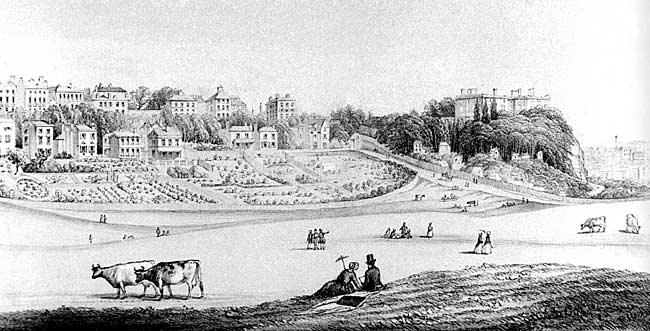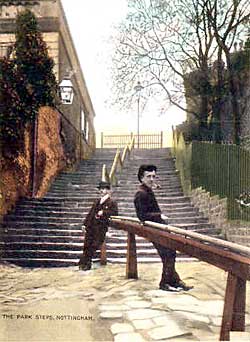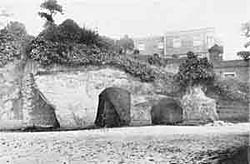< Previous | Contents | Next >
Nottingham Park
 A
A Victorian view of the Park. The ruins of Nottingham Castle are visible on the right of the panorama.
Nottingham Park is a curious district and I believe that it is unique to find an area of anything like this size devoted to good class houses each with its own garden in the heart and centre of a great manufacturing city. It is the private property of the Duke of Newcastle and its history is interesting. In the reign of Henry II. Peveril had license to enclose ten "forest" acres of land ad faciendum pomerium. As these "forest" acres approximated to fifty statute acres, Peveril's orchard must have been about 500 acres. The Park to-day only measures about 130 acres, so a good deal of the original enclosure must have been disposed of since Peveril's time. All through the middle ages the Park seems to have formed a sports ground for the occupants of the castle and it is rather curious that it is referred to by Geoffrey Kniveton, Constable of the Castle and Clerk of the Forest in 1508, as "The Coney Garth" or rabbit warren, while a totally different enclosure bears the title of "Castle Appleton" which seems to point to the ancient orchard. Anyway, by the 17th century there were no trees, apple or other, growing in it for Mrs. Hutchinson comments on the fact that in 1642 there was only one tree in the whole area and draws a fanciful parallel between its knarled appearance and the character of Richard III. who was supposed to have planted it. Some planting must have been done soon after her time for about 1760 we find Gilbert Wakefield learning Greek while pacing up and down a fine avenue of elms on the west side of the park, which were not felled till 1835.
The present leafy condition of the park dates from 1855 when Siberian Elms were freely planted along the newly laid out roads, the earliest to be planted being those in Tunnel Road which, as they were transplanted from the "Castle Nurseries," wherever they may have been, got a further start of their neighbours.
I do not know when deer were first introduced to the park, but the herd was sold in 1717, although carted stags were hunted in the park as late as 1798. It was the poaching of a particularly fine stag in Nottingham Park that brought Thomas Booth, whose tombstone dated 1752 we saw in St. Nicholas' Churchyard, into prominence. This stag couched about where the Park Offices are now built and was well-known to keeper and poachers alike. To get it Moore enlisted the assistance of a friend who discharged a gun in what is now Tatters-hall Drive and so drew off the keeper. Moore shot the stag in his absence and dragged the carcase into Brew House Yard where he was safe from arrest.
The whole aspect of the park must have been rather like what Annesley Park is to-day, but in the valleys there were packets of particularly good soil, noticeably about the fishpond and where Park Ravine, whose ancient name was "The Cow Drinks" is. In this soil was grown liquorice and considerable quantities of hemp which was made into whipcord. During the Princess Anne's sojourn in Nottingham a great oblong garden called "The Queen's Garden" which still remains as a private garden, comes into notice, and it is doubtful whether this has not something to do with pleasure grounds laid out for Queen Isabella about 1330.
When it was first decided to utilize the park for building purposes it was proposed to make the chief entrance into Tattershall Drive, and so in 1856 the tunnel was driven through from Derby Road. However, the gradient proved too steep, and so another lay-out of the ground provided by Mr. T. C. Hine and his assistant, Mr. R. Evans, was adopted, and the tunnel was allowed to sink into a mere footway The first house in the park was built on Newcastle Terrace in 1827.
The cavalry barracks, some traces of which still remain at the end of Barrack Lane, were of considerable importance, being the Headquarters of the Command before its removal to Sheffield in 1855. The first stone was laid by the Officer Commanding the 7th Light Dragoons in 1792 and there must have been guns attached for in 1801 we have a note of artillery salutes in the park to commemorate the surrender of the Danish Fleet.

Park Steps in the early 1900s.
Park Steps excite admiration by their picturesque-ness, but their history is even more interesting than their appearance. The oldest road in this neighbourhood, whose age it is impossible to speak of in terms of years, was the track from east to west on the high land above the jungle of the Trent Valley. This road, after passing by, or through, the ancient enclosure of Nottingham, proceeded by Pepper Street, Houndsgate, Lenton Road and Cut Through Lane to the west. When the castle enclosure was constructed this thoroughfare was pushed northward and followed up Standard Hill, Postern Street, Park Row and finally struggled down the precipice in what is now known as Park Steps, at the foot of which it turned to the south along Park Valley and re-joined its ancient line at the junction of Castle Grove with Lenton Road. It could never have been more than a footpath or possibly a bridle road and to-day it is a public right of way and cannot be closed on one day each year as are the other roads in the park. This is the reason for the well-known "Posts" at the Lenton exit to the park—there is a public footway but no thoroughfare for wheeled traffic.
In 1828, as we have seen, Lenton Road was formed, and as far as Park Valley it is for the most part cut through the solid rock. In the course of excavations a great subterranean chamber was found which not only communicated with the park but was connected with the kitchen department of the castle. Of this some traces remain to-day. This appears to have been the larder of the castle and into it animals would be driven for slaughter. In olden times, before modern scientific winter feeding of animals obtained it was the custom to slaughter the bulk of the flocks and herds about Michaelmas and preserve their carcases with salt in great pits. This formed the main supply of meat during the winter and as salt was both scarce and expensive
it is not surprising to find that the diet of half-putrid meat spread leprosy and other similar troubles throughout the land. A few animals were kept for breeding and these eked out a miserable existence till the spring brought herbage for their fodder once more.
Castle Grove represents the western moat of the castle and in the garden behind number 2 are very extensive and instructive remains of the lowest floor of Edward IV.'s Castle of Care. These remains include a well, a typical 15th century doorway and a portion of a spiral stair. These remains are not open to the public.
The Park Bowling Green behind the house at the corner of Hermitage Walk and Lenton Road was formed in 1807. How old the game of bowls is, I cannot say, but it seems to have been played all through the Middle Ages, while the presence of many bowling greens in Nottingham at the close of the 18th century points to its great popularity.

The Hermitage on Castle Boulevard in the 1920s.
The curious rock habitations in the gardens of the "Hermitage" have exercised the minds of generations of antiquaries. They have been assigned to Druids and to Romans and all sorts of strange explanations have been suggested. The one tangible fact about them is that they are continually referred to during the Middle Ages as the "Chapel of St. Mary le Rock." In 1474 they were in the hands of the Prior of Lenton who exchanged them with Edward IV. for a chapel at Tickhill. I think that they were probably an hermitage and their age is hoary, for when the course of the Leen was altered its new flow had to be diverted so as not to disturb them, showing their importance even in those far off days.
Many other objects of interest may be found in the Park such as the curious sculptures in quite modern caves in the gardens of the houses on the Rope Walk, but one of the least known facts is that the gateposts of the North Road Gate are those which carried the toll bar on Derby Road until the early days of the 19th century while the magnificent view from "The Bay of Biscay" on Newcastle Promenade is worth a long journey to see.
